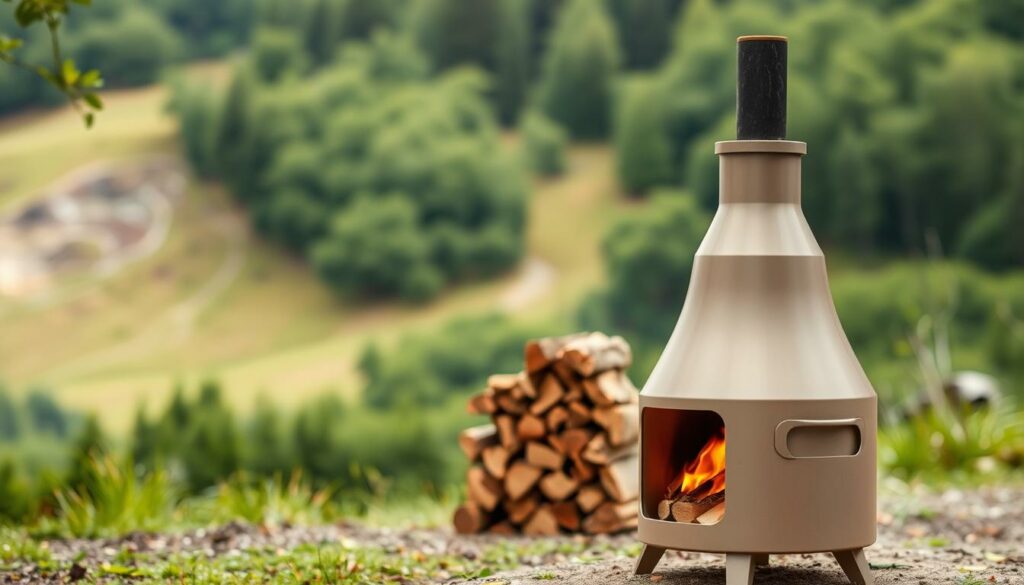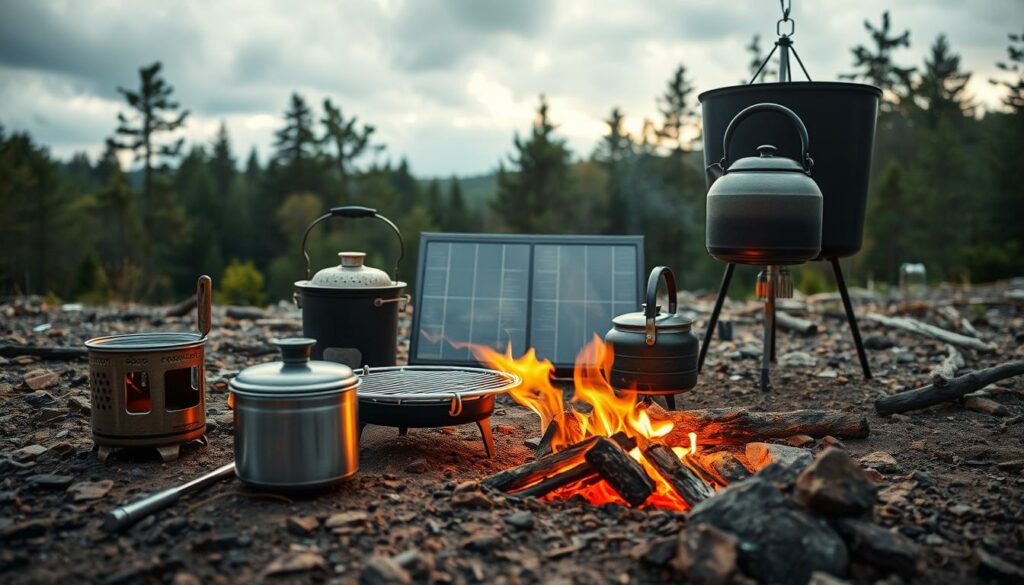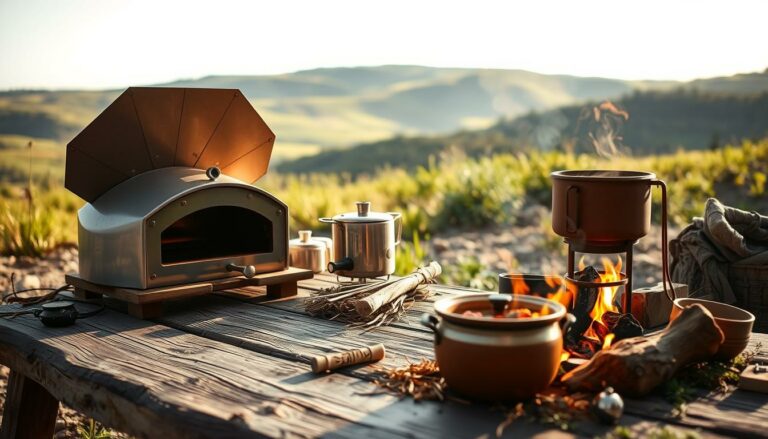In today’s world, energy independence and living sustainably are key. Off-grid cooking solutions offer a way to cook without harming the planet. This guide will show you how to use solar ovens and rocket stoves for eco-friendly cooking. These methods are good for the environment and help you be ready for emergencies.
Off-grid cooking lets you use less energy in your kitchen. Solar ovens and rocket stoves are great because they use less fuel. Using these methods makes your kitchen more eco-friendly and helps you be more self-sufficient. Let’s see how these solutions can make your kitchen more efficient and green.
When the power goes out, cooking becomes a big challenge. Having different off-grid cooking tools is key to keeping your family fed. You can choose from solar, propane, wood, and Dutch ovens. These options are perfect for cooking for many or just a quick meal.
Key Takeaways
- Off-grid cooking fosters energy independence and sustainable living.
- Understanding different cooking methods can enhance emergency preparedness.
- Solar ovens and rocket stoves offer eco-friendly and efficient cooking solutions.
- Investing in versatile cooking tools ensures reliable meal preparation during outages.
- Diverse cooking options contribute to a self-sufficient and eco-conscious lifestyle.
Introduction to Off-Grid Cooking
Living an off-grid lifestyle means finding new ways to cook without electricity. This skill is key for those living far from cities and during power outages. Knowing alternative cooking methods boosts self-sufficiency and readiness, making life more sustainable and strong.
Cooking without electricity can be fulfilling, letting you try out alternative cooking methods like solar ovens and wood-burning ovens. These tools use sunlight and wood to cook, unlike electric ovens. For example, solar ovens can get as hot as 350 degrees Fahrenheit, making them a green choice.
Rocket stoves are another great option, needing little wood to cook a lot. They use less wood than open fires, making them good for the environment. Propane stoves, like big burners for boiling and frying, cook well and reliably, important for off-grid cooking.
More people are choosing sustainable cooking options, like those found in “A Year in an Off-Grid Kitchen”. This book helps manage an off-grid lifestyle, covering seasonal cooking, food preservation, and different diets. Learning these alternative cooking methods helps prepare for emergencies and connects us to traditional and green cooking ways, supporting a full off-grid living experience.
Benefits of Off-Grid Cooking
Off-grid cooking has many perks, like being more self-sufficient and using different fuels. It also helps you be ready for emergencies. By using these methods, you can cut down on your need for electricity and traditional fuels. This makes you more independent and secure, even when things get tough.
Self-Sufficiency
One big plus of off-grid cooking is learning to cook for yourself. About 18% of U.S. homes are into off-grid living, including cooking without electricity. This way, you can make meals on your own, even when power is out. It’s great for city folks and anyone wanting to live more sustainably.
Alternative Fuel Sources
Off-grid cooking also means using different fuels. For instance, rocket stoves need just a few twigs to work well. Solar ovens can be used all year if it’s sunny enough, cutting down on the need for regular fuels. It’s smart to have several ways to cook, so you’re not stuck without a way to make food during emergencies.
Emergency Cooking Preparedness
Being ready to cook in emergencies is key to living independently. After disasters, like hurricanes, propane use can jump by up to 300%. Having various off-grid cooking options, like a BBQ or DIY stoves, helps. Preppers often have ten different cooking methods ready, making them feel more secure and prepared.
Solar Ovens: Harnessing the Power of the Sun
Solar ovens are changing off-grid cooking by using the sun’s energy. They are great for city families wanting to be self-sufficient and use less energy. We’ll look at how solar ovens work, check out top models, and guide you to make one at home.
How Solar Ovens Work
Solar ovens use mirrors to focus sunlight into a cooking area. This heat is high enough to cook food without fuel. For example, the GoSun Fusion can get up to 550 degrees Fahrenheit, even on cloudy days.
These ovens are much better than old solar cookers. The GoSun Fusion cooks fast on sunny days and slower at night. It can cook for 4-6 people and is five times more efficient than regular ovens.
Best Solar Oven Brands and Models
Here are some top brands in solar cooking:
| Brand | Model | Capacity | Weight | Price |
|---|---|---|---|---|
| GoSun | Fusion | 3.2 liters | 17.2 lbs | $399 |
| GoSun | Go | 420 ml | 2 lbs | $119 |
| GoSun | Sport | 1.2 liters | 7 lbs | $239 |
DIY Solar Oven Guide
Making your solar oven is a fun project. It combines DIY skills with green living. You can use cardboard, aluminum foil, and acrylic sheets to start.
- Build a box with insulation, like newspaper, between cardboard layers.
- Use aluminum foil inside to reflect sunlight and keep heat.
- Make a clear top with glass or acrylic to let in sunlight and keep heat in.
- Make sure your oven is sealed well to keep the heat inside.
This DIY method lets you make a solar oven that’s cheap and good for the planet.
Rocket Stoves: Efficient and Reliable
Rocket stoves are known for their top-notch efficiency and dependability. They use fuel wisely and waste less, making them great for cooking with minimal fuel. They’re also eco-friendly, perfect for those who care about the planet and practicality.

The Science Behind Rocket Stoves
Rocket stoves work thanks to their clever design. They have an insulated chamber that makes fuel burn fully. This means more heat and less smoke, making them efficient and eco-friendly.
These stoves burn fuel in a way that cuts down on smoke and pollution. This makes them better than old wood-burning stoves for keeping air clean indoors.
Top Rocket Stove Options
There are many great rocket stoves out there. Here are some top picks:
| Model | Price | Weight | Dimensions | Fuel Types | Warranty | Special Features |
|---|---|---|---|---|---|---|
| EcoZoom Versa | $149.95 | 14.5 lbs | 11 x 11 x 12.5 in | Wood and Charcoal | 2 years | Cast iron top, silicone handles |
| EcoZoom Dura | $129.95 | 16.2 lbs | 10.5 x 10.5 x 10.5 in | Wood and Charcoal | 2 years | Sheet metal body, ceramic insulation |
| Minuteman K Stove | $289 | N/A | N/A | Wood | N/A | Military-grade construction |
| Hot Ash Mini Stove | $79 | 1 pound | N/A | Wood | N/A | Compact and lightweight |
| Bruntmor Camping Rocket Stove | $109 | N/A | N/A | Wood | N/A | Portable design |
| Marsh Kettles Flat Pack Mini Rocket Stove | $76 | 6 pounds | N/A | Wood | N/A | Flat-pack for easy transport |
| SHTFandGo Bullet-Proof Rocket Stove | $185 | N/A | N/A | Wood | N/A | Heavy-duty design |
EcoZoom stoves, like the Versa and Dura, are top choices. They get great reviews for their build and how well they work. Rocket stoves offer safe, green cooking options to over 1 billion people worldwide.
Cooking with Propane off the Grid
Propane is a reliable choice for off-grid cooking. It provides stable heat, even in emergencies. Portable propane stoves ensure you have a dependable heat source, no matter the weather or location.
Propane is efficient for off-grid cooking. It lasts twice as long as electric heating systems. In emergencies, propane heats evenly and costs less than electric systems.
Portable propane stoves offer versatile cooking options. They heat more efficiently than natural gas, meeting various culinary needs without electricity. Many propane appliances, like stoves and ranges, work without electricity, perfect for power outages.
Propane appliances save money. Propane water heaters cost less to buy and install than electric ones. Tankless propane water heaters also cut carbon emissions by up to 60%, supporting sustainable living.
“Homeowners can receive rebates for installing propane systems, making it a cost-effective home energy solution,” affirms the Propane Education & Research Council.
Propane stoves are great for long-term storage, unlike wood. They heat faster and cool quicker than electric stoves. This reduces the risk of burning food and ensures precise temperature control.
For urban families and those preparing for emergencies, portable propane stoves are key. They work well with solar water heating and photovoltaic systems. Propane ranges are also durable, supporting daily use without problems.
In summary, portable propane stoves offer efficiency, cost savings, and eco-friendliness. They are a wise choice for off-grid cooking.
Using Wood-Burning Stoves for Off-Grid Cooking
Wood-burning stoves are great for off-grid cooking. They use traditional methods and sustainable fuel. They’re key for those who want to be self-sufficient, using their own firewood. We’ll look at the different types and safety tips.
Types of Wood-Burning Stoves
There are many wood-burning stoves, each for different needs. Here are a few:
- Traditional Wood Cookstoves: Great for homesteads, these stoves cook food and heat water. They’re perfect for baking and making soups.
- Portable Wood Stoves: Good for camping, these stoves are easy to use but might not have all the features of home stoves.
- Hybrid Stoves: These stoves use wood and other fuels. They’re useful when you run out of firewood.
Safety Tips for Wood-Burning Stoves
- Maintain Fire Safety: Always watch the fire and keep flammable things away. Having a fire extinguisher nearby is smart.
- Regular Cleaning: Clean the chimney and stove to avoid fires. Regular checks keep them working well.
- Proper Ventilation: Make sure air circulates well to avoid carbon monoxide. Use detectors for extra safety.
- Temperature Control: Place pots right to control heat. Use thermometers for better cooking.
- Emergency Preparedness: Knowing how to use fuel and manage firewood helps in emergencies.
With the right stove and safety steps, off-grid cooking is fun and efficient. It lets families enjoy traditional cooking safely and sustainably.
The Versatility of Dutch Ovens in Off-Grid Cooking
Dutch ovens are key for off-grid cooking. They work with wood, charcoal, and buffalo chips. Charcoal briquettes are easy to store and provide steady heat. A 12” Dutch oven is perfect for families or solo cooks.
Dutch ovens were vital for pioneers and cattle drives. Today, a seasoned Dutch oven shows its reliability with a golden color. For best results, use 6-7 briquettes under and 15-20 on top.
Cooking a variety of meals is another reason Dutch ovens are celebrated. They’re great for frying, baking, and boiling. They handle chicken, pork, beef, and bread well. For baking, a 10” oven needs 20 coals, and a 12” needs 24.
Recipes show Dutch ovens’ power. A chocolate cake in a 10” Dutch oven serves 9 and bakes in 30 minutes. Banana bread in a 12” oven cooks for 1 hour with 24 briquettes.
For campfire cooking, preheat the Dutch oven for 15-20 minutes. Adjust for cold or windy days to keep heat steady. Use a 22-inch wooden spoon to handle coals safely.
Dutch ovens are great for cook-offs or family meals. They make off-grid cooking rewarding, ensuring tasty meals in tough conditions.
Portable Stoves and Campfire Cooking
Whether you love camping or need to cook outdoors, learning to cook outside is key. Portable stoves and campfire methods are both flexible and reliable for meals in the wild.

Overview of Portable Cooking Solutions
The market now has many portable cooking devices for different needs. From light backpacking stoves to strong rocket stoves, here’s what you need to know:
- DESERT & FOX Ultralight Mini Camping Stove: Uses 7/16” butane/propane canisters and is great for short trips.
- Canway Rocket Stove: Burns many types of organic matter, making it very versatile.
- Coleman Bottle Top Propane Stove: Works with one-pound propane bottles, perfect for those already set up.
- Lixada Camping Stove: Has an alcohol burner, used by the military for long-term use.
- Esbit Folding Stoves: Loved for being small, these stoves are popular among adventurers and the military.
- Bushcraft Essentials XL Outdoor Stove: Burns almost any organic matter, saving fuel.
| Stove Model | Fuel Type | BTU Output | Weight |
|---|---|---|---|
| Camp Chef Everest 2X | Propane | 20,000 per burner | 12 lbs |
| Coleman Cascade Classic | Propane | 10,000 per burner | 8 lbs |
| Primus Profile | Propane | 12,000 per burner | 10 lbs |
| Jetboil Genesis Basecamp Stove | Propane | 10,000 per burner | 9 lbs |
| Snow Peak Home & Camp Burner | Propane | 8,333 | 3 lbs |
Campfire Cooking Techniques
Good campfire cooking is about skill and knowing how to work with the fire. Here are some basic tips:
- Fire Construction: Use the teepee or log cabin style for a steady burn.
- Heat Management: Keep a consistent bed of coals for even cooking.
- Cooking Methods: Use direct heat for grilling and indirect heat for baking or slow cooking.
- Equipment: Dutch ovens and cast-iron skillets are great for their versatility and durability.
- Safety Tips: Always have a bucket of water nearby and never leave a fire alone.
Knowing about portable stoves and improving your outdoor cooking skills will greatly improve your camping meals. Whether it’s the dependability of gas stoves or the flexibility of wood-burning stoves, having the right knowledge and tools is key for off-grid cooking.
Essential Tools and Accessories for Off-Grid Cooking
Starting off-grid cooking needs the right tools and accessories. We’ll look at key non-electric gadgets and manual tools for a self-sufficient lifestyle. We’ll also talk about emergency lights for cooking in the dark.
Manual Kitchen Tools
Manual tools are key when there’s no electricity. Hand-crank can openers, grinders, and juicers are must-haves. A mortar and pestle keep spices fresh, and a hand-crank egg beater keeps your cooking going.
A multi-purpose axe is more than just for chopping wood. It’s also for driving stakes and making firewood. A multi-tool can replace many tools, like pliers and can openers. A strong hand saw and a bow saw with extra blades are great for cutting wood.
Emergency Light Sources
Lighting is a big challenge when cooking in the dark. Portable LED lanterns, flashlights, and headlamps are must-haves. Solar-powered lights and kerosene lamps are also good options.
Use outdoor extension cords rated at least 15 amps for safe power. It’s better to have two 50-foot cords than one 100-foot cord.
| Tool | Primary Use | Benefits |
|---|---|---|
| Manual Can Opener | Opening cans | Essential for food prep |
| Multi-Purpose Axe | Chopping wood, driving stakes | Versatile utility |
| Hand-Crank Grinder | Grinding grains and spices | Maintains flavor |
| Emergency Lantern | Providing light during outages | Ensures visibility |
| LED Headlamp | Hands-free lighting | Convenience and mobility |
Having the right tools makes off-grid cooking efficient and fun. Invest in these essentials to be ready for any situation.
Alternative Fuel Sources for Off-Grid Cooking
Looking into alternative fuel sources for off-grid cooking is key for a sustainable lifestyle. Using eco-friendly fuels and sustainable cooking methods helps the environment. It also lets people cook without needing the traditional energy grid. This section explores different renewable options, so you can keep cooking tasty meals off the grid.
Solar energy is a great choice, using sunlight to power solar ovens. Solar ovens work best in sunny places but can cook slower than other methods. They’re a green and renewable way to cook.
Gas cooking is also popular, using propane or LPG. Portable camping stoves use butane canisters, making them easy to use. Outdoor stoves that use a 9kg LPG cylinder can cook like electric stoves. But, they need a little power to start, so they must be suitable for off-grid use.
Wood-burning stoves are a classic choice, needing a steady wood supply. Portable woodburners are good for occasional use, while bigger stoves can heat homes and cook meals. They’re great in winter but not in summer because they add extra heat. If you have lots of trees, it can be cheaper and more sustainable.
| Fuel Source | Example Devices | Advantages | Considerations |
|---|---|---|---|
| Solar | Solar Ovens | Zero emissions, renewable | Requires sunny weather, slower cooking |
| Gas (Propane, LPG, Butane) | Camping Stoves, Multi-Burner Outdoor Stoves | Replicates electric cooking, versatile | Needs ignition power, depend on fuel availability |
| Wood | Wood-Burning Stoves | Heat + cooking, reduced costs with local wood | Not practical in summer, wood supply needed |
| Biomass | Biogas Digesters, Biodiesel Generators | Utilizes waste, renewable | Requires setup and maintenance efforts |
Biomass energy systems are another good choice, using organic materials like wood and waste. Biogas digesters and biodiesel generators are examples. Make sure you have a steady supply of biomass and check them regularly for best performance.
In summary, using renewable resources and alternative fuels for off-grid cooking is important. It supports eco-friendly fuels and sustainable cooking. It also helps you cook efficiently without the traditional energy grid.
Practice and Preparation Tips for Off-Grid Cooking
Mastering off-grid cooking takes practice and preparation. It’s key to know different cooking methods like solar ovens, rocket stoves, and wood-burning stoves. This knowledge helps you adapt to various situations and use off-grid cooking solutions well.
Learning to Use Different Cooking Methods
To get good at off-grid cooking, learn about different methods. Start with solar ovens, which can get hot on sunny days. Then, try rocket stoves for their efficiency and reliability.
Propane stoves are also useful, thanks to their flexibility. Wood-burning stoves and cooking over an open fire are other options. Knowing these methods will improve your cooking skills and make you more versatile off the grid.
Safety and Maintenance Considerations
Safety is critical when cooking off the grid. Always follow the maker’s safety rules for each device. For example, keep wood-burning stoves clear of debris to avoid fires.
It’s also important to keep your cooking gear in good shape. Clean and check your devices regularly. This ensures they work well and keeps you safe while cooking. Proper care also makes your equipment last longer.
Conclusion: Picking the Right Solution for Your Needs
Choosing the right off-grid cooking method is all about finding a balance. It’s about being practical, efficient, and sustainable. Each option has its own strengths and weaknesses, fitting different lifestyles.
Solar ovens use the sun’s power, making them clean and green. They’re easy to use but cook food slowly. Rocket stoves, on the other hand, cook fast and use less fuel, making them eco-friendly.
Wood-burning stoves are versatile and cook food well, but need skill. Dutch ovens are easy to use and cook a variety of dishes, scoring high. Campfire cooking is affordable and versatile, perfect for beginners.
Each method supports sustainable cooking choices. The high cost of traditional cooking, over $2.4 trillion a year, shows the need for change. By choosing wisely, we can live more sustainably and reduce our environmental impact.
FAQ
What is off-grid cooking?
Off-grid cooking means making meals without electricity or gas. It uses solar ovens, rocket stoves, and other fuel sources.
Why is off-grid cooking important?
It’s key for being self-sufficient, like during power outages. It also helps those living far away cook without usual power. Plus, it’s good for the planet, using solar and wood energy.
What are the benefits of off-grid cooking?
It boosts self-sufficiency and uses different fuels. It’s great for emergencies and cuts down on electrical use. It makes cooking reliable and safe.
How do solar ovens work?
Solar ovens use sunlight to heat food. They focus the sun’s rays in a cooking area. This cooks food without fuel.
What are the best solar oven models?
Top picks are the Sunflair Solar Oven, GoSun Sport, and All American Sun Oven. They’re efficient, easy to carry, and simple to use.
How can I build a DIY solar oven?
Make one with cardboard, foil, and plastic or glass. Online guides and videos can help you build a working solar oven.
What makes rocket stoves efficient?
Their design boosts air flow and fuel burning. This means they cook well with little fuel, making them eco-friendly.
What are some top rocket stove options?
Best choices include the EcoZoom Versa, SilverFire Survivor, and Stovetec Deluxe Wood Stove. They’re durable, efficient, and easy to use.
What are the benefits of using propane for off-grid cooking?
Propane is handy for off-grid cooking. It’s easy to carry and use with many appliances. It’s a reliable heat source for emergencies or camping.
What types of wood-burning stoves are available?
There are cast iron stoves, portable stoves, and modern efficient ones. Each meets different cooking needs and settings.
What safety tips should be followed when using wood-burning stoves?
Keep it well-ventilated and away from flammable things. Clean it often and use seasoned wood to avoid creosote buildup.
How versatile are Dutch ovens for off-grid cooking?
Dutch ovens are very versatile. They’re great for baking, frying, stewing, and roasting. Their cast iron makes them durable for use over fires or with charcoal.
What are some effective campfire cooking techniques?
Use direct heat for grilling and coals for baking or roasting. Tools like tripods and Dutch ovens help. Managing the fire’s heat is key.
What are essential tools and accessories for off-grid cooking?
You’ll need manual tools, durable cookware, matches or lighters, and emergency lights. These help with cooking in the dark.
What alternative fuels are suitable for off-grid cooking?
Good alternatives are biomass, alcohol, solar, and wind energy. They’re sustainable and eco-friendly, reducing need for traditional fuels.
How can I prepare and practice off-grid cooking methods?
Learn and try out solar ovens, rocket stoves, and campfire cooking. Keep your gear in good shape, follow safety rules, and get more practice. This ensures safe and efficient off-grid cooking.
Source Links
- http://www.englishhomestead.com/2018/07/prepping-on-budget-easy-cooking-off-grid.html
- https://thesurvivalmom.com/off-grid-cooking-methods/
- https://thetinylife.com/off-grid-solar-cooking/
- https://microshowcase.com/microtech/off-grid-cooking/
- https://permies.com/t/148378/sneak-peek-Year-Grid-Kitchen
- https://permies.com/wiki/152738/Year-Grid-Kitchen-Kate-Downham
- https://gosun.co/blogs/news/cooking-without-electricity-tips-and-tricks-for-off-grid-meals?srsltid=AfmBOoqLThPP4QJQFGyRWG8nD2HD2Kas9_2iK3S-Urpm3vjGDk3xzioR
- https://science.howstuffworks.com/environmental/green-science/solar-cooking.htm
- https://gosun.co/products/best-solar-cooker-fusion?srsltid=AfmBOopMlqhBrXkVeg96BRAQ0IzUFCXlj3PAeVhfPW2w5TXz8ZbUYl7i
- https://www.bioliteenergy.com/products/ecozoom-versa?srsltid=AfmBOorUU0bOMui5MdCJmqtQLiFG-c3G7-6cwqvHhSFoBqr5lk3QML11
- https://www.cindyheathwrites.com/practical-skills-blog/how-a-tiny-rocket-stove-can-help-save-the-world
- https://www.pewpewtactical.com/best-rocket-stoves/
- https://paracogas.com/blog/propane-the-growing-interest-in-off-grid-living
- https://www.warehouseappliance.com/blog/off-grid-propane-oven/?srsltid=AfmBOoqfgOAwlOHSJWTH30pIVR8piAjNtNmbFr89TNdm0bentjkWl8DL
- https://www.warehouseappliance.com/blog/propane-stove-benefits/?srsltid=AfmBOop4u8yWyUSJR_u3rQbjcyPvwRf6c5cDtO0VO_sICvAWN6FsRIOT
- http://inthewilderness.net/2022/01/06/consider-a-wood-burning-cookstove-for-your-off-grid-kitchen/
- https://www.backdoorsurvival.com/cooking-off-grid-wood-burning-stove/
- https://melissaknorris.com/podcast/living-like-its-the-1800s-wood-stove-cooking-frugal-living-tips/
- https://thesurvivalmom.com/dutch-oven-cooking/
- https://melissaknorris.com/podcast/cast-iron-dutch-oven-outdoor-campfire-cooking/
- https://offgridsurvival.com/portablecampstoves/
- https://gearjunkie.com/camping/best-camping-stoves
- https://vtoman.com/blogs/news/camping-cookware-power-stations
- https://theoffgridcabin.com/the-ultimate-list-must-have-off-grid-tools/
- https://www.small-cabin.com/forum/1_10210_0.html
- https://gridfree.store/blogs/how-to-articles/how-to-cook-off-grid?srsltid=AfmBOoraKizeH1mLKl67-OBD2P-UroIJspI2-FnzF3LJaAvBT_aDP7Xz
- https://www.newrcompany.com/post/chefs-induction-stove-empowering-off-grid-living-with-sustainable-cooking-solutions
- https://campuspress.yale.edu/ledger/living-off-the-grid-a-guide-to-sustainable-energy-sources/
- https://valleyfoodstorage.com/blogs/inside-vfs/how-to-cook-without-electricity-heat-food-without-power?srsltid=AfmBOoqF_YxpxVs0GV3TefKCWfczVQ4OqPLAgsUStZZhwYOa9GXmvNOj
- https://www.offgridweb.com/survival/grid-down-chef/
- https://www.mypatriotsupply.com/blogs/scout/key-methods-for-survival-cooking?srsltid=AfmBOoof4Z_jLP-xIDGHFvEQfjiez8065DoVlL2AeiEmWcSgT8Ne-0OW
- https://www.homebiogas.com/blog/clean-cooking/?srsltid=AfmBOopJCCnM1BfHqaDFTXwVfKVw72XOoBPwqha_eTku14xJFY6p5od6
- https://www.ecolivingvibes.com/off-grid-cooking-methods/

